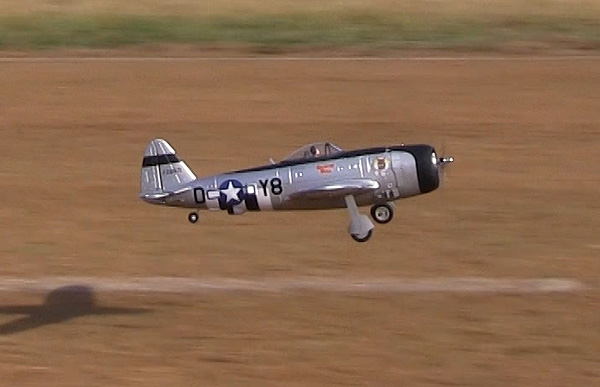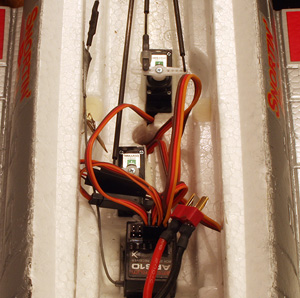



The P-47 is famous for its great flying characteristics and despite its small size, this
one flies very well!
Text, photos and video by Tom Hintz
Posted - 1-17-2014
The Parkzone P-47D Thunderbolt PNP is a foamy 4-channel, electric powered warbird with stand-off scale looks at a surprisingly affordable price. Also, the Parkzone P-47D Thunderbolt PNP is set up to accept optional retracts (E-Flite #EFLG100) and also optional flaps though neither are needed to fly it.
The Parkzone P-47D Thunderbolt PNP has a 42.2 in (1070mm) wingspan with an overall length of 36.9 in (940mm) which makes getting it to and from the flying field in one piece a snap in most of today’s cars. It is made of Z-Foam™ which seems to be both light and relatively durable. It’s not going to bounce if you crash but chances are you can repair many forms of damage with simple epoxy. The flying weight comes in right at 40-oz which is not bad at all for this size plane.
The Parkzone P-47D Thunderbolt PNP comes with removable fixed landing gear and steerable tail wheel but they include a clear, stick-on protective belly skid for gear-off landings. I was surprised to see wheels just under 2-3/4”-diameter that will actually work on prepared grass runways. Plus they look good as well.
Power comes from a factory installed 15-size 950Kv BL Outrunner that is controlled by an E-Flite 30A Pro brushless ESC that is installed for you. The recommended battery is the uber-common 3S 11.1V 2200mAh 25C Li-Po pack many electric fliers may already have a bunch of. It comes with a 9.5 x 7.5 prop which seems to work fine for most flying and it affords good ground clearance for easier takeoffs and landings.

Servos are factory installed showing
that they can't keep the wires clean
looking either.
Though the electronics are factory installed you do have to assemble a few things. I started by installing the horizontal stabilizer which comes in two pieces that slip together through the tail of the plane. Four strips of clear tape secure the horizontal stabilizer halves into fairings on the fuselage.
Next I added the included aileron Y-harness to the aileron servo wires and fed that through the hole in the wing saddle and pulled them into the electronics cavity as I set the wing in place. Three long screws secure the wing in place. If needed removing the wing for transport is not overly difficult.
Next I installed the fixed landing gear. The only thing to watch for here is that there is a left and right wheel and strut. They will fit in either side but one way produces a massive toe in problem that will make taxiing or take-off from a runway impossible. Installed in the correct sides the wheels are parallel to the fuselage. This is easy to see if you look for it. You will notice that the gear screw into plates in the wings that will accept retracts if you decide to do that. Snap on the plastic simulated doors and the landing gear is complete.
All that remained was installing the receiver, binding and setting up the control surfaces. The control surfaces turned out to be almost dead on neutral (appearing anyway) as the Parkzone P-47D Thunderbolt PNP came out of the box. I didn’t make any adjustments other than reversing the rudder and elevator to get them going in the right direction but that was it. I also checked the CG and found that with the battery about ½” back from is most forward position the balance was very close as well. It was still just a tiny bit nose heavy but that is a bunch better than tail heavy, especially to start with.
The maiden flight for the Parkzone P-47D Thunderbolt PNP went smoothly. I had to add a few clicks of left aileron and a bit of down elevator and it flew straight and level at about ¾ throttle. Inverted flight takes some down elevator to stay level but that is easily manageable.
On landing I found that the ailerons looked like they were slightly favoring a left roll but the plane flies level. The rudder does not look out of alignment and the Parkzone P-47D Thunderbolt PNP seems to track straight so I looked for a twist in the wing but none is visible. It flies fine as it is so I am leaving it be and will get some time on it and see if anything changes. (In the end it did not change and continued to fly just fine with the ailerons slightly out of whack visually)
Overall the Parkzone P-47D Thunderbolt PNP flies easily. Takeoffs need some right rudder and rolling the throttle on gradually while holding up elevator keeps it from nosing over. It does not like low-speed much and will “fall through” if you use too much elevator on landing. It also seems like it wants to tip stall at lower speeds if you get brave on the controls. Landings are fine if you just keep the fuselage level and carry just a bit of throttle and let it settle in.
Power is more than sufficient with plenty of guts to climb out at a good angle. If flew the Parkzone P-47D Thunderbolt PNP through 6 battery packs and got an easy 6-minutes from each with a good mix of full and partial throttle flight.
The Parkzone P-47D Thunderbolt PNP is a fun little plane to fly but I think new pilots should look elsewhere for a first low- winger. The ground handling and stall characteristics are no trouble for moderately skilled pilots but could be frustrating for novices, especially without help.
With a street price of just $109.99 (10-23-2013, PNP version #PKZ5375) the Parkzone P-47D Thunderbolt PNP is a fun warbird for fly-ins or just sport flying with a bit of a military flare. With help from an instructor many relatively novice pilots can learn to fly this low-winger and have fun with it.
To see the Parkzone P-47D Thunderbolt PNP web page – Click Here
Have a comment on this review? - Email Me!